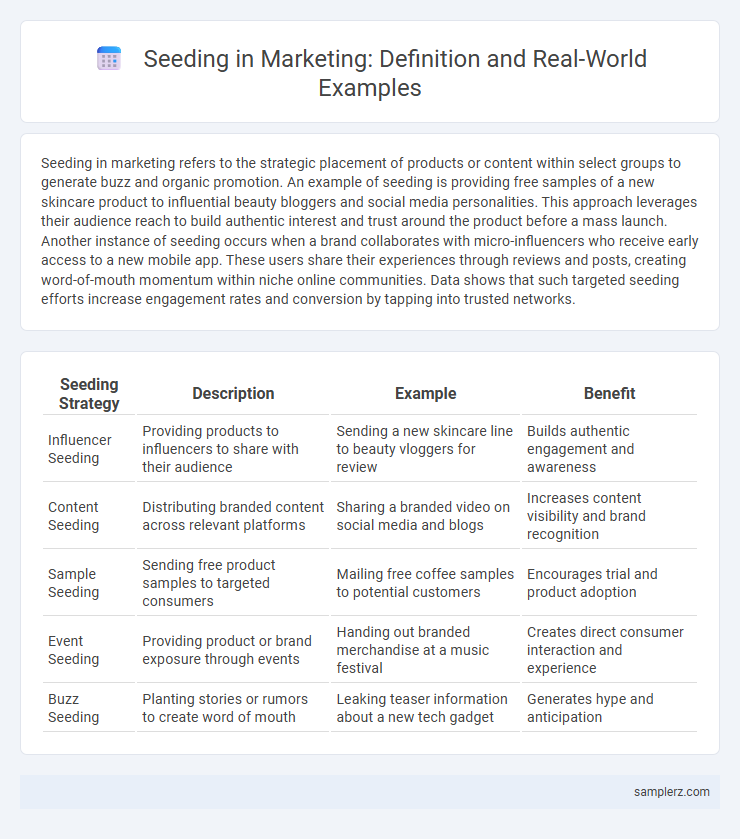Seeding in marketing refers to the strategic placement of products or content within select groups to generate buzz and organic promotion. An example of seeding is providing free samples of a new skincare product to influential beauty bloggers and social media personalities. This approach leverages their audience reach to build authentic interest and trust around the product before a mass launch. Another instance of seeding occurs when a brand collaborates with micro-influencers who receive early access to a new mobile app. These users share their experiences through reviews and posts, creating word-of-mouth momentum within niche online communities. Data shows that such targeted seeding efforts increase engagement rates and conversion by tapping into trusted networks.
Table of Comparison
| Seeding Strategy | Description | Example | Benefit |
|---|---|---|---|
| Influencer Seeding | Providing products to influencers to share with their audience | Sending a new skincare line to beauty vloggers for review | Builds authentic engagement and awareness |
| Content Seeding | Distributing branded content across relevant platforms | Sharing a branded video on social media and blogs | Increases content visibility and brand recognition |
| Sample Seeding | Sending free product samples to targeted consumers | Mailing free coffee samples to potential customers | Encourages trial and product adoption |
| Event Seeding | Providing product or brand exposure through events | Handing out branded merchandise at a music festival | Creates direct consumer interaction and experience |
| Buzz Seeding | Planting stories or rumors to create word of mouth | Leaking teaser information about a new tech gadget | Generates hype and anticipation |
Understanding Seeding in Marketing
Seeding in marketing involves strategically placing products or content with influential individuals or groups to generate authentic word-of-mouth promotion. By targeting key opinion leaders or micro-influencers within specific communities, brands can amplify their reach and credibility organically. Effective seeding leverages social networks and consumer trust to create a ripple effect that boosts brand awareness and drives engagement.
Key Benefits of Seeding Strategies
Seeding strategies in marketing involve distributing content or products to influencers and early adopters to generate organic buzz and authentic engagement. This approach enhances brand credibility, expands reach through targeted networks, and accelerates word-of-mouth promotion, leading to higher conversion rates. Effective seeding maximizes cost-efficiency by leveraging trusted voices, amplifying brand awareness without extensive advertising spend.
Influencer Seeding: Real-World Examples
Influencer seeding in marketing involves sending products to key influencers to create authentic content that drives brand awareness and engagement. For example, Glossier's early strategy focused on gifting products to micro-influencers, resulting in organic social media buzz and exponential growth. Another case is Daniel Wellington, which leveraged influencer seeding by providing watches to lifestyle bloggers, fostering genuine endorsements that boosted global sales.
Product Seeding Campaigns that Worked
Product seeding campaigns like Airbnb's initial strategy invited influential travelers to experience and share their stays, generating authentic buzz and rapid user growth. Another successful example is Tesla providing charity event attendees with test drives, creating high-impact word-of-mouth among affluent prospects. These campaigns leverage targeted product exposure to key opinion leaders, driving organic endorsements and brand credibility.
Case Study: Seeding in Social Media Marketing
In social media marketing, seeding involves strategically distributing content to influential users to maximize organic reach and engagement. A notable case study is the collaboration between Nike and fitness influencers on Instagram, where targeted seeding led to a 35% increase in user-generated content and a 20% boost in brand mentions within three months. This approach leverages influencer credibility to amplify brand visibility and drive authentic audience interactions across multiple social media platforms.
How Brands Use Seeding for Launches
Brands use seeding in marketing by strategically sending new products to influencers or loyal customers before a public launch to generate authentic buzz and social proof. This method leverages word-of-mouth marketing, where recipients share their experiences organically on social media platforms, increasing visibility and building anticipation. Effective seeding campaigns can accelerate product adoption and enhance brand credibility in competitive markets.
Micro-Influencer Seeding Success Stories
Micro-influencer seeding has proven effective in boosting brand awareness, with campaigns like Glossier's targeted gifting strategy resulting in organic content creation and high audience engagement. Beauty brands leveraging micro-influencers on Instagram reported a 25% increase in conversion rates compared to traditional influencer marketing. These success stories highlight the power of authentic connections, niche audiences, and micro-influencer credibility in driving purchase decisions.
User-Generated Content Through Seeding
User-generated content through seeding involves strategically distributing products or experiences to targeted influencers or loyal customers who then create authentic content, amplifying brand reach organically. Brands benefit from increased trust and engagement as consumers perceive these endorsements as genuine recommendations rather than traditional advertising. This method leverages social proof to drive brand awareness and boost conversions by harnessing satisfied customers' voices across social platforms.
Seeding vs. Traditional Advertising
Seeding in marketing leverages targeted distribution of content through influential individuals or niche communities to generate authentic engagement and organic brand awareness. Traditional advertising relies on broad, paid media placements such as TV, radio, or digital ads to reach a wide audience with controlled messaging. Seeding often yields higher trust and conversion rates by fostering peer recommendations, while traditional advertising excels in scale and immediate exposure.
Best Practices for Effective Marketing Seeding
Effective marketing seeding involves identifying and engaging key influencers and early adopters within target communities to naturally promote products or services. Leveraging authentic content creation and facilitating genuine user experiences can amplify brand visibility and trust effectively. Consistent monitoring and responsiveness to feedback ensure ongoing optimization and strengthen relationships for sustained campaign success.

example of seeding in marketing Infographic
 samplerz.com
samplerz.com